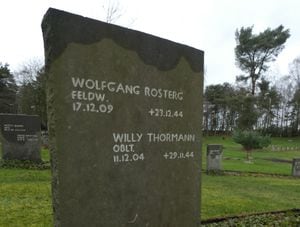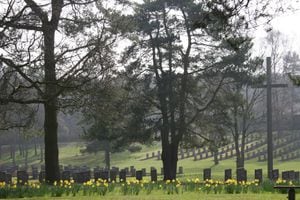Story behind Cannock Chase grave of German soldier murdered for renouncing Nazis
Wolfgang Rosterg wasn't a good Nazi – and it cost him his life.

He lies in the German Military Cemetery at Cannock Chase, the simple tombstone giving no clue to the brutal circumstances of his death, which created national headlines and were to lead to five other deaths.
His story has been researched by Staffordshire military historian Richard Pursehouse, who has visited the grave which is shared with another German who met a tragic end, Willy Thormann.
"I think he was another victim of German 'justice', but seems to have been overlooked," says Richard.
Feldwebel (Sergeant) Rosterg was a German prisoner of war, but must have stuck out like a sore thumb among the others, being aged 35, able to speak English which meant he could act as an interpreter, and middle class. He was of heavy build and wore pebble glasses. Fatally, he renounced Nazi ideology.
In late 1944 a group of hardcore SS prisoners cooked up a plan to escape from their camp at Devizes in Wiltshire, but the British authorities got wind of it and the ringleaders were sent to a remote camp in Scotland.
For some reason Rosterg, who had not been involved in the plot, was among those transferred to Camp 21 at Comrie, Perthshire.

Rosterg arrived at the camp on December 22, and that evening there was a discussion in one of the huts during which he was asked if he was a National Socialist. "Certainly not," he replied.
It was a response that turned out to be his death warrant. Other prisoners suspected him of having betrayed the escape plan – it seems never to have been established that he did, but in any event he was viewed as being a deserter and a collaborator.
He was subjected to a mock trial, although there was no pretence of there being any justice involved as his accusers already had the rope ready.
In short, other prisoners savagely murdered a soldier they considered a traitor to the Nazi cause. Medical evidence showed that he was probably already dead by the time they strung him up in a lavatory.
After the crime the British investigators met a wall of silence. Those who could have given evidence were fearful of reprisals against their families back in Germany. However it seems promises of anonymity helped to loosen tongues and in July 1945, two months after the war in Europe had drawn to a close, eight German prisoners of war were brought before a military court in London accused of murder.
One witness told the hearing that Rosterg had said that he had "been around the world enough not to believe any more in National Socialism".
After a two-week trial which was extensively covered in the press, six were found guilty. Five were condemned to death and the sixth was sentenced to penal servitude for life. The condemned men, the eldest of whom were just 22, were hanged at Pentonville on October 6, 1945.
It is claimed that this was the largest execution of men in England for the same crime.
"His killers are buried where they were executed – most of them in the grounds of Pentonville Prison," said Richard.
In the same grave as Rosterg at Cannock Chase is Willy Thormann, a 39-year-old Oberleutnant who was found hanging from a tree outside the same camp just a few weeks before Rosterg's death. It was recorded as suicide, although there were suspicious circumstances.

Shropshire was dotted with German prisoner of war camps and one death of a German POW never really satisfied the inquiring mind of North Shropshire coroner Alfred Thomas Smith in what was known as the 'Skeleton in the Woods'” incident at Hawkstone.
A skeleton, suspended from a rope from a tree, was found near the site of a German prisoner of war camp. Nearby were letters giving the name of the prisoner. In correspondence with Mr Smith, the widow said her husband had fair hair and that he also had some false teeth, both of which concurred with the official records for the prisoner.
Suspicion grew after Mr Smith ordered a pathological examination which revealed that the skeleton was of a man with dark hair with a full set of natural teeth.
The coroner, unable to close the case satisfactorily, had a theory that an SS man, anxious about the treatment he might receive after the war from relatives of his victims, assumed the identity of another prisoner – whom he then hanged.
What appears to be the same incident is recounted in the 2001 book 'Hodnet In Wartime' written by the late Hodnet historian Gerald Mothershaw, who. however. does not put a sinister interpretation on the discovery.
Gerald gave the date of 1947, a post-war time when prisoners were allowed into the local community to do work.
This particular prisoner did not return one day, and it was later learned he had received a letter from his father, saying that the Russians had advanced into East Germany and his farm would be under Russian occupation. It was assumed that he had absconded and was on his way back to Germany.
Gerald said that years later, while walking in dense undergrowth, Gamekeeper Jones saw some rags hanging from a tree in Kenstone.
“It was the sad remains of the escaped prisoner. Rather than face the thought of living under the control of the Russians, he had hanged himself.”





